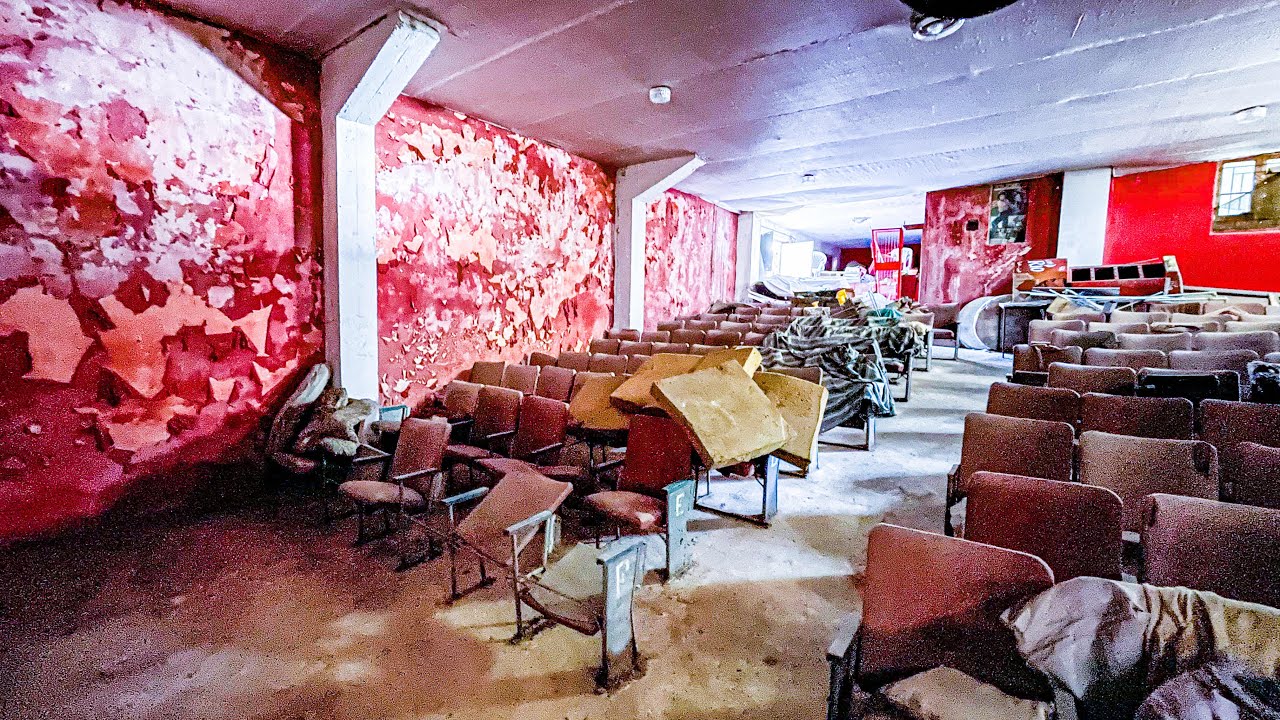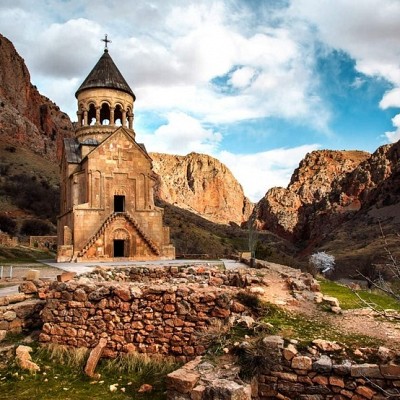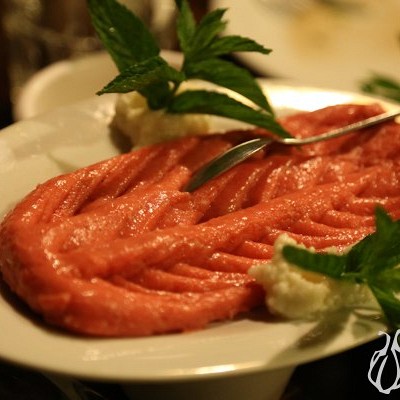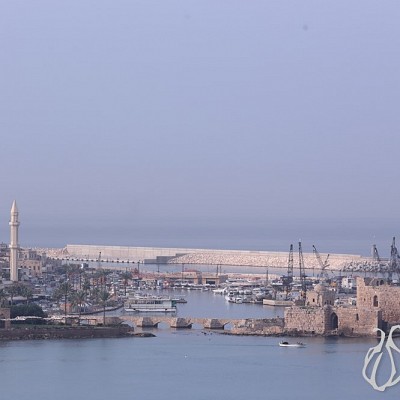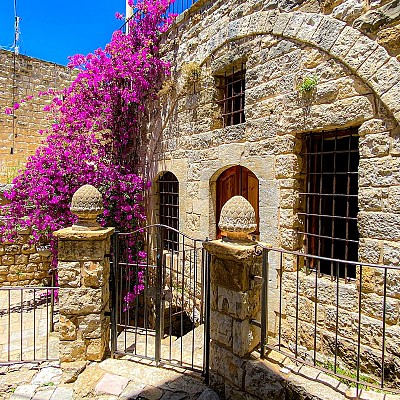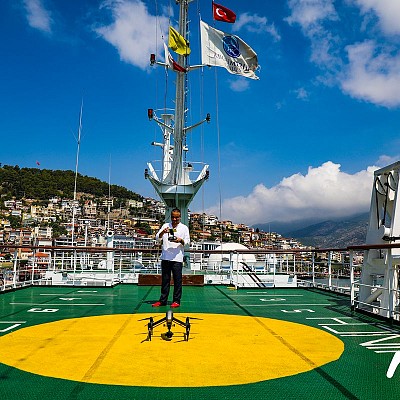Ftouh Keserwan
Day 1:
Our first stop in Ftouh Keserwan was Ghazir, a town with an area of 5.42 km² and a population of 8,200. Anyone coming to Ghazir can check out the municipality’s website for more information on all the must-see sites. We kicked off with breakfast at Furn Harb Slaybi, a bakery established in the 1960s. The owner began preparing the dough to make a delicious cheese manoucheh with mozzarella and akkawi cheese on a wood-fired oven.
We drove to the Monastery of Saint Anthony (Deir Mar Antonios). The church was beautiful with all the intricate carvings on the entrance door to the archways inside and floral etchings on stone columns. In the Covent of Saint Francis, we went into the room the Ottomans used as a prison. The monastery was built on the remains of a previous one, Mar Youhanna's monastery. Our guide even told us that Emir Bashir Chehab the 2nd was born there in 1768. We also went to Beit Salib, Father Yaacoub’s childhood home. There, we talked to one of the nuns responsible for taking care of the place. We also passed by the house Ernest Renan stayed in when he visited Lebanon on his archaeological expedition. Renan split his findings with the Ottomans at the time. As such, many of Lebanon’s artifacts can now be found in museums in Turkey and France.
In addition, we visited the Chateau Musar winery. The company was established in 1930. Our guide is a part of the third generation of owners. We went into a wine cellar consisting of 3-4 floors of hundreds of thousands of wine bottles. The wine cellar was dusty, full of cobwebs, and cold, left with no intervention whatsoever. The result of Chateau Musar's process is a wine every sommelier knows.
Before the end of our visit to Ghazir, we took a walk around the tranquil woods. The woods were vast and empty. That is until I stumbled upon Bio Attitudes glass cabins. I couldn't tell where the woods stopped, and the cabin appeared. What a great idea! Each cabin comes with its own outdoor patio and a small pool. The owner, Sandra Joseph, explained that they took on this venture because the mountain alongside the area wasn’t contaminated with chemicals. Everything grown in the mountain is bio-organic. Bio Attitude also has a line of tapenade spreads called Olive Bio. They have 5 flavors: walnut, chili, almond, black olives, and basil flavored. For the walnut, chili, almond, and basil flavors, the type of olive chosen, green or black, depends on what best matches the taste of the olives.
In Kfour, we went to the start of the spring trail (Darb el Eyun), named so for the multiple water sources it passes through. The trail passes through several historical sites. We stopped by an old silk factory and a church. I went up the ladder to find out where their bell was made, but I had no luck. The entire bell was painted green, hiding any possible etchings! We also went to the church of Mar Gerios and the church of Saint Charbel.
We stopped at Abu Tony’s for some sandwiches, which has been open for 40 years. Whether you’re craving roast beef, cheeseburgers, grilled halloumi, or fries, Abu Tony's has it all. As I took a bite of the burger, I was reminded of home. A simply comforting cheeseburger: meat, cheese, and coleslaw. They also serve chicken liver sandwiches with mayo or garlic sauce. Homemade sandwiches at Abu Tony’s are definitely worth a trip from Beirut!
We ended our tour in Kfour on a mountainside that was cut and is now a pasture. Our guide explained that this site might have been used as a strategic point during the war. The view was truly amazing. But standing there looking over the valleys underneath, all I could think of was the land's potential to be used for wheat crops for the entire village.
To end our day, we headed to High Noon for desserts. The desserts looked and tasted amazing. The strawberry tart broke apart easily and was not soggy. It had the perfect level of sweetness. High Noon also includes the third largest horse track in Lebanon, with horse stables, a bar, bungalows and mini villas for rent, and a motel.
Day 2:
Day 2 started off with a plate of raw meat at Sassine Korkomaz’s butchery in Ghinneh. According to Sassine, there is no secret to good meat, only what’s known as “nafas”, a flair that accompanies passion and love for food. However, you can’t expect good food if your ingredients aren’t of good quality.
The next village was Jouret el Termos. At Furn El Ftouh, I had an incredibly light zaatar manoucheh. The dough was soft and slightly toasted on the edges. The dough was just as rested as it should be. In El Ftouh Butchery, I had some cow liver. It was still warm and tasted oddly similar to goat liver. It was super fresh.
I talked to Paul Korkomaz who gave us an overview of Jouret el Tormos. With 3 churches, Mar Chalita, Saydet el Najet, and Mar Youssef church, and 2 hotels, Hotel Adonis and Hotel Saint Paul, the village was a thriving summering location. However, due to the war, the village’s growth stumped.
We visited one of the mentioned churches. After a long climb on a not-too-sturdy ladder, I got a view of the church’s bell. The lines on it, which are now an instant indicator of a Beit Chabeb bell for me, gave away its creators. The date carved on it is 1909. I also checked the second one. That one was made in the year 2000 in Mazraat Yahchouh.
We strolled around and ended up walking into Center Esperance. Cinema Riviera, which would later become Centre Esperance, began operating in 1978. When discussing the history of Cinema Riviera, the Rmez brothers reminisced what it was like running the cinema before the war.
We walked to Saj Ya Hala which has been operating for 12 years. They make Markouk flatbread and manakish. The bread is healthy, sugar-free, and whole wheat. They made me organic local eggs with awarma, which is made in-house, shanklish, and Zaatar blend on the saj. I dipped it in labneh and was delighted with how soft the bread was. It was like a biscuit on the outside. This place is famous and rightfully so!
Next, we went to Bon Choix to try some of Maya Romanos Korkomaz’s sweet treats. At the shop, they have everything from exotic tart, profiteroles, chocolate tart, etc. I had the chocolate tart. It had a nice crunch to it and was decadent. The moment I saw it, I knew I’d like it.
At Hotel Saint Paul, Fadi Boulos Korkomaz gave us a brief glimpse of the hotel’s history. The hotel was originally located on Bliss street but then moved here during the war. At first, it was a small hotel, but it was later expanded due to demand. The hotel was at its peak; you’d have to reserve a year in advance. It was small for the number of customers coming in. Wadih el Safi sang there and so did Samira Toufic. The place was incredibly lively.
We also visited the monastery of Saint Therese, where the nuns have been making all sorts of preserves: jams, zaatar, olives, etc. I had some of their jam with cake. It was delicious
The second hotel, Hotel Adonis, has unfortunately been neglected recently.
We walked to a silk factory called Kerkhenna. All the town was living off the production of the silkworms. The factory was privately owned and was recently turned into a private home.
The region is known for its black honey. We got to visit an apiary that makes honey under The Beekeeper brand name. They have oak-tree honey and eucalyptus honey. Oak-tree honey is rich in minerals and is great for diabetics. The bees are moved to the south to make orange-blossom honey. The beekeeper advised us to get honey from a beekeeper we trust because honey is all about trust.
Back in Kfour, we visited Cidra’s factory. The factory makes apple cider and sparkling apple juice. The company supports apple farmers in Bsharri, Baskinta, and Tannourine among others who may not be able to sell all their produce. The apples are juiced in Bsharri after which, the juice is placed in a machine to control temperature. When it’s ready, it’s transferred into a tank where CO2 is added to get sparkling apple juice. They also have 0% sparkling apple juice. The juice itself was slightly acidic. It was sparkling, but it didn’t burn. It wasn’t too sweet, which is what you’d think apple juice would be. It was incredible.
We headed to Sausage Cafe in El Ghineh for a quick bite. The place started out making sujuk, pastrami, and sausage sandwiches. Soon enough, they expanded their menu to offer burgers and subs. Their most popular sub is the tandoori chicken. The burger was flavorful. With every bite, I wanted more. The sandwich bread was soft yet toasted. The chicken was tender.
In El Ghineh, at 900m above sea level, Akel Sayagh led us into a shop where they sell seasonal preserves. There, we met Zeina, who makes a variety of cheeses and labneh. They have cheese with olives and thyme, cheese with raisins and walnuts, and labneh with olives and chili. The cheese had a flavor reminiscent of home. I couldn’t stop eating it.
Akel also took us to the village’s water spring, known as Abaal’s spring, named after the god Baal. People come from all over to drink its water due to its health benefits. We walked through the ruins of Baal’s temple. During the Byzantine era, the temple was turned into a Byzantine church. Roman and Byzantine influences are evident in the tiling. We continued walking to Adonis’s rock. There was both a temple and a carving on the rock. The carving depicts Adonis defending himself against a wild boar and eventually dying. According to legend, he died here. The carving also depicts Ashtartoot grieving over Adonis.
We also went to Hotel Francis. What I saw surprised me. The hotel was built in 1982 but renovated in 2005. It currently boasts 2 restaurants, a big wedding venue, and a lobby. At the dinner table, I had good Arak and good food. The cheese rolls were crunchy. The sausages were delicious.
Day 3:
While everyone else was still asleep, I took the opportunity to have an early breakfast alone before heading out to tour Ftouh Keserwan for the third day of our tour. Then, we set off for a second breakfast at Furn el Ain in Yahchouh. Furn el Ain is run by Lena Seaad and has been open for 23 years. She made me a manoucheh with zaatar and one with eggs and awarma on the saj oven. The one with eggs and awarma was closed, huge, and rich. The zaatar one was soft and slightly toasted on the side. The zaatar in it was incredible. The eggs-and-awarma manoucheh was exceptional. The dough was thin and browned. I also had a magical cheese manoucheh. This place is a must-visit and definitely on my Top 10 Bakeries in Lebanon.
We arrived at Jabal Moussa Biosphere Reserve. The biosphere reserve has 3 main entrances: Qehmez, Mchati, and Chouwan. The core zone has an area of 12km², but that area becomes 65km² with all the transition zones and villages. At the Chouwan entrance, we went into a shop that sells crafts made from items in the reserve by the village’s women: honey collected from the reserve, jams, etc. Strolling through the reserve, I was left in awe at the beauty of it all. I couldn’t have felt any closer to God.
In Yahchouh, we visited the church of Mar Gerios. Yahchouh starts at 250 meters above sea level and reaches 1300 meters. The monastery of Mar Gerios was established in the 18th century. It happened to be Mar Gerios day. While there weren’t any large celebrations due to COVID, people still showed up to visit the site and pray. We tried to find out more about the church bell, but there were no etchings on it.
At Jalset Ward, one must start with a cup of rose water. I came here a while ago to take some photos of Chouwan and promised to come back again. It took some time—2 years to be exact— but I made it. Jalset Ward is a family-owned restaurant specializing in Lebanese cuisine. The owners cook the food and make kibbeh, cheese rolls, and more. They even grow the vegetables they use. With nature sounds in the background and food just like my wife makes at home, the experience at Jalset Ward was top-notch.
We also headed out to meet Milad Assef in Yahchouch. Milad specializes in taxidermy. It started out as a hobby. After 15-20 years and clients from all over, it became a career. He took us through his process. A bird, for example, needs to be put in the freezer for a maximum of 4 hours after being hunted. It is, then, skinned and processed. Then, the inner skin is cleaned.
We reached Ghbeleh, considered the capital of Ftouh Keserwan. Ghbeleh ranges from 650-1100 meters above sea level, which means summers are cool and winters are cold. Ghbeleh has a population of 4000 people. It is home to 7 churches. There, I stopped at El Beiruty's Butcher Shop where I ate some delicious candy-like liver. We stopped by a couple cafes in Ghbele before heading off to meet Maher and his mother Souad for lunch. We stopped at a sidewalk cafe that serves fresh juice, cocktails, and anything sweet. We also passed by a juice kiosk and a place specializing in homemade preserves: peanut butter, banana jam, amongst other flavors, pickles, and labneh.
It was finally time for lunch! We headed to Nammoura with no more stops on the way. I was very excited because Souad was making Fawaregh and Kroush, stuffed intestines and tripes ,respectively. I was also surprised to find fava-bean-stuffed puffs made with cornflour. Souad was also making rosewater. Cutting into the intestines was effortless as they were so soft. As I cut them, the intestines spilled out a mixture of rice, minced meat, and chickpeas. A squeeze of lemon was all it needed to become the perfect bite.
Every day I discover new things, but, more importantly, new people full of hope. This trip to Ftouh Keserwan was no exception. Everything about this trip to Ftouh Keserwan was great. While we saw a lot on this trip, we barely saw anything from what Ftouh Keserwan has to offer, from what Lebanon has to offer. I will definitely be back!
FTOUH Keserwan Episode, Google maps list: https://goo.gl/maps/KNdYi6V9pXjZKgSJ8


















